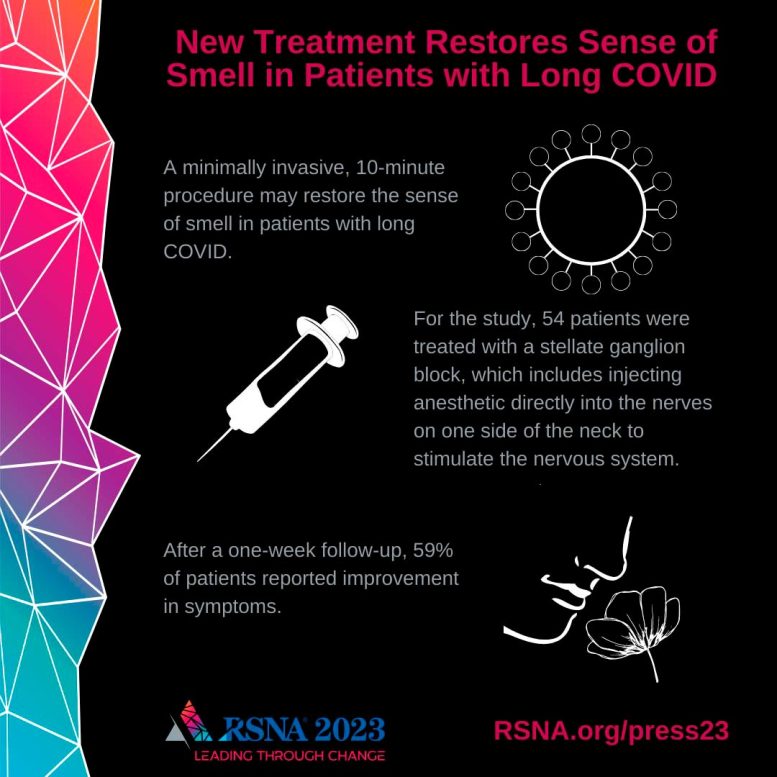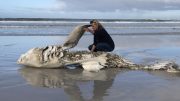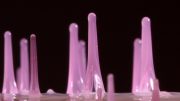
A new minimally invasive treatment using CT-guided stellate ganglion block shows promise in restoring the sense of smell in long-COVID patients with parosmia. Early results from a study involving 54 patients indicate significant symptom improvement, marking a potential breakthrough in treating this COVID-19-related condition.
Using an image-guided minimally invasive procedure, researchers may be able to restore the sense of smell in patients who have suffered with long-COVID, according to research being presented this week at the annual meeting of the Radiological Society of North America (RSNA).
Understanding Parosmia
Parosmia, a condition where the sense of smell no longer works correctly, is a known symptom of COVID-19. Recent research has found that up to 60% of COVID-19 patients have been affected. While most patients do recover their sense of smell over time, some patients with long COVID continue to have these symptoms for months, or even years, after infection, negatively impacting their appetite for food and their overall quality of life.
“Post-COVID parosmia is common and increasingly recognized,” said the study’s lead author, Adam C. Zoga, M.D., M.B.A., professor of musculoskeletal radiology at Jefferson Health in Philadelphia, Pennsylvania. “Patients can develop a distaste for foods and drinks they used to enjoy.”
The distorted sense of smell can also affect smell perception, and some patients may suffer from phantosmia, a condition that causes people to detect smells—foul or pleasant—that aren’t in their environment.
Potential Treatment
To assess a possible treatment for patients with long-term post-COVID parosmia, researchers looked at the potential benefits of CT-guided stellate ganglion block. Part of the autonomic nervous system, which regulates involuntary processes including heart rate, blood pressure, breathing, and digestion, the stellate ganglia are nerves on each side of the neck. They deliver certain signals to the head, neck, arms, and a portion of the upper chest.
“Other treatments have failed to date. This injection is working.” — Dr. Adam C. Zoga
The research team used a stellate ganglion block, which includes injecting anesthetic directly into the stellate ganglion on one side of the neck to stimulate the regional autonomic nervous system. The minimally invasive procedure takes less than 10 minutes, and no sedation or intravenous analgesia is necessary. Stellate ganglion block has been used with varying degrees of success to treat a number of conditions, including cluster headaches, phantom limb pain, Raynaud’s and Meniere’s syndromes, angina, and cardiac arrhythmia.
“Parosmia has previously been reported as a rare disorder occurring after brain trauma, brain surgery, stroke, viral syndromes, and with some head and neck tumors,” Dr. Zoga said. “We were not entirely confident that the procedure would work for parosmia.”
Study and Outcomes
For the study, 54 patients were referred from an ear, nose, and throat specialist after at least six months of post-COVID parosmia that was resistant to pharmaceutical and topical therapies.
CT guidance was used to position a spinal needle at the base of the neck for injection into the stellate ganglion. The researchers added a small dose of corticosteroid to the anesthetic in the pharmacologic preparation, suspecting that the COVID virus may be causing nerve inflammation.
“The initial patient had a tremendously positive outcome, almost immediately, with continued improvement to the point of symptom resolution at four weeks,” Dr. Zoga said. “We have been surprised at some outcomes, including near 100% resolution of phantosmia in some patients, throughout the trial.”
Follow-up was obtained for 37 patients (65%), with 22 (59%) of the 37 reporting improved symptoms at one week post-injection. Of these 22, 18 (82%) reported significant progressive improvement by one month post-procedure. At three months, there was a mean 49% improvement in symptoms (range 10% to 100%) among the 22 patients.
Twenty-six patients returned for a second injection given on the other side (contralateral) of their neck after at least a six-week interval. While the second injection was not effective in patients who did not respond to the first injection, 86% of patients who reported some improvement after the first injection reported additional improvement after the contralateral injection. No complications or adverse events were reported.
“Other treatments have failed to date,” Dr. Zoga said. “This injection is working.”
Co-authors are Sarah I. Kamel, M.D., T. Rohan, M. A. Moriarty, Johannes B. Roedl, Ph.D., M.D., Vishal Desai, M.D., and Jeffrey A. Belair, M.D.










What did they do to eliminate the possibility of it being a placebo effect, or that the patients would have recovered on their own?
It says it’s a study. There’s no study, yet? I found the press release “New Treatment Restores Sense of Smell in Patients with Long COVID” by RSNA. Scitechdaily has added helpful subheaders but it’s otherwise verbatim. There is no control group mentioned. Maybe they just jumped-the-gun on publication a week too early? It sounds like good news, but I don’t know what to do with it either.
The AI photo is very disturbing. The AI seems to have confused baby’s breath (gypsophilia paniculata) for hogweed (heracleum mantegazzianum). Were the photo real, she would likely require hospitalization. Her lips are most of her face, so the photosensitive swelling has already begun.
I took a look at RSNA’s news page. This press release is still their latest, and it’s mid-December now. Maybe they discussed it at their RSNA meeting, but one needs to be a member to know. I guess that leaves this story being that there might be news in future.
That AI woman’s jaw has definitely gotten bigger since I last looked.
This is not a study…it’s speculation. Doesn’t sound like there was a control group, and there apparently was no OBJECTIVE olfactory testing. Other treatments have shown objective improvement, but even the participants who didn’t improve objectively, said that they (subjectively) improved. So the placebo effect is at play, and subjective evaluation is not objective improvement.